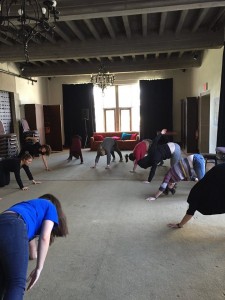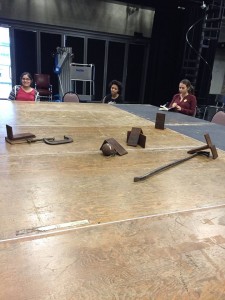(This post is by Marisa Arellano, BMC class of 2016.)
Most people are surprised to learn that Mark cast Lear about a month into rehearsals. For the first month of the process nobody knew who would be playing who. I wanted to take a moment to explain some of the more unconventional things you’ll see popping up on this blog.
The work we do in the Bi-College Theater Program is often based firmly in ensemble. Ensemble, in simplest terms, is a group of artist who come together to make something. Before we could jump into the world of Lear as characters, we needed to learn how to be together as people and as artists. It sounds like a simple thing to do–most of us spend a lot of time in groups of people. But truly being present and connecting with a group is a challenging thing to do. Everything we’re doing in this production is based on the premise of coming together.
There are a lot of different ways we attack this common goal of togetherness. Sometimes it’s a game (The Chair Game is a personal favorite), sometimes it’s a check-in, and sometimes it’s making prolonged eye contact with someone. It can be difficult to grasp initially why we spend so much time playing games and making eyes at each other instead of constantly digging at the text.
It makes sense when you think about it. The language of a play is lost if you’re not actually connecting with the people you’re sharing a stage with (or, in our case, a table). Even the most damning of curses and banishments wouldn’t really matter if we weren’t really seeing each other. Especially with Shakespeare, a strong ensemble is key to giving the words life instead of treating them like delicate pieces of poetry we can’t touch.
This is how ensemble is coming up in Lear. Every play is different. In the past we’ve done plays where no one has a defined character, plays where multiple people play the same role, and plays that exclusively featured hermits. Our work can be a little unconventional but ultimately our concerns are pretty simple–we want to come together.

 We did a few rounds of the ‘chair game’ we learned from the NIE Theatre’s workshop (pictured), further working on our strategy and making sure that not more than one person was going for the same chair at a time. Mark then joined us, offering his check-
We did a few rounds of the ‘chair game’ we learned from the NIE Theatre’s workshop (pictured), further working on our strategy and making sure that not more than one person was going for the same chair at a time. Mark then joined us, offering his check- Most interesting to me in this exercise was the moment in which the person made her choice of where to place her object. We really took the time to be in our bodies, taking about 15 or so seconds to think of where to place our metal pieces. Something to consider is that our characters in Lear who make much bigger decisions presumably take a lot more time. The game also caused an interesting juxtaposition from the powerful feeling I had in deciding it was my turn to go and the vulnerability I felt at first of not knowing where to place my metal piece.
Most interesting to me in this exercise was the moment in which the person made her choice of where to place her object. We really took the time to be in our bodies, taking about 15 or so seconds to think of where to place our metal pieces. Something to consider is that our characters in Lear who make much bigger decisions presumably take a lot more time. The game also caused an interesting juxtaposition from the powerful feeling I had in deciding it was my turn to go and the vulnerability I felt at first of not knowing where to place my metal piece.